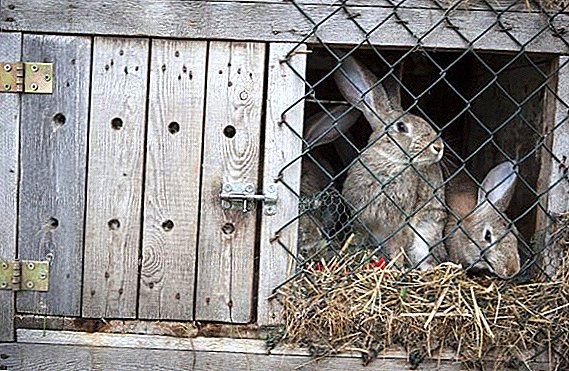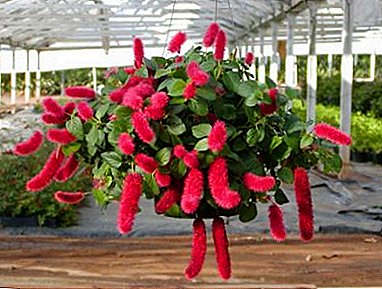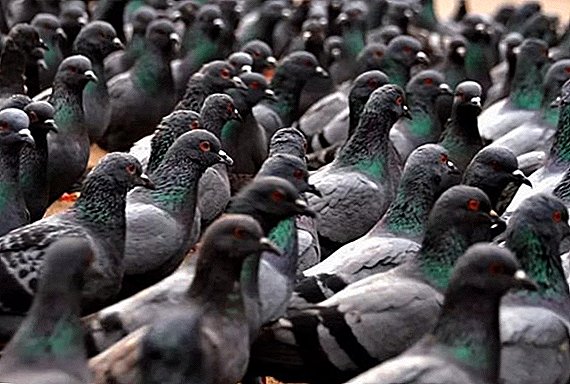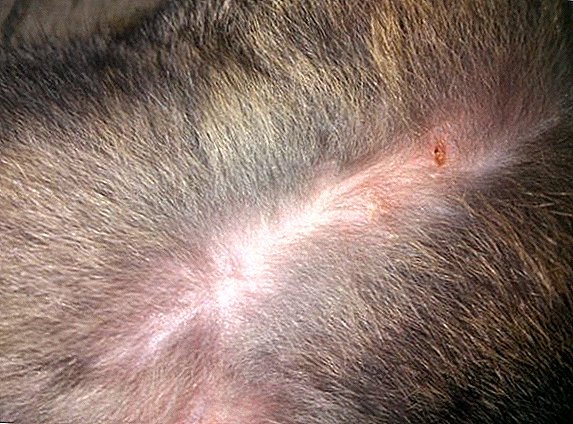 Fungal infections do not spare people or animals. One of these diseases, dangerous for rabbits, is versicolor. In animals, hair loss is observed, they often itch. The disease very quickly affects healthy individuals and can spread to humans. In order to be fully armed, it is necessary to know the causes of this disease, its symptoms and methods of treatment.
Fungal infections do not spare people or animals. One of these diseases, dangerous for rabbits, is versicolor. In animals, hair loss is observed, they often itch. The disease very quickly affects healthy individuals and can spread to humans. In order to be fully armed, it is necessary to know the causes of this disease, its symptoms and methods of treatment.
Causes of
Deprive is a fungal disease transmitted by cats or dogs directly on contact or through infected objects. It can occur in the process of molting, through open wounds from cuts, as well as due to hormonal disruption, in which the protective functions of the body are reduced. 
Moult
Changing wool in a rabbit is a natural process that takes place twice a year: in spring and autumn. If new hair begins to break through on bald areas, this is normal. But if this does not happen, then it is necessary to consult a specialist, since baldness may indicate development of depriving.
Did you know? The excessive fertility of rabbits is due to the fact that the rabbit is able to endure two offspring at once, conceived at different times, since the structure of the uterus is bifurcated in her uterus.
Fleas and ticks
Carriers of these blood-sucking parasites are cats and dogs. With a long stay on the body of the animal, the rabbit may develop an allergy and, as a result, loss of hair. From insect bites are formed wounds, which can get a fungal infection. 
Cuts and wounds
Open wounds to the body from cuts and bites also pose a threat and serve as sites for infection and infection.
Hormonal imbalance
This disease, caused by improper maintenance of animals, which occurs:
- due to lack of vitamins K, E, selenium, leading to avitaminosis;
- from an excess of dairy products and soybeans, which adversely affects the production of its own hormones.
Important! Lichen is dangerous not only by the speed of spread, but also by the fact that bacteria that cause purulent processes enter the body through the affected skin.
Symptoms
There are many varieties of lichen, most often this infection affects young rabbits or sick individuals with low immunity. Detect the disease can be on such grounds:
- Itching - the animal often scratches itself with paws or bites at the locations of the disease foci.
- Hair loss - a naked body part is formed at the site of the fungus. During the molting period, this symptom may go unnoticed.
- The spot on the skin in the form of an oval - the wool in this place is as if trimmed, the skin is pink in color, the color of the edge of the spot is more saturated, the skin is swollen, flaky.
- Ulcers - formed, if not started treatment. Later they burst with the release of ichor and pus.

Types of lichen
Before you begin treatment, you need to determine what kind of deprivation will have to fight. You can install it in appearance.
Pink
Occurs due to a pink rash virus. It is non-infectious, for 45 days the body of the rabbit itself copes with the virus. 
Ringworm
This species of lichen has a fungal character. The disease spreads very quickly in the form of oval-shaped spots (2 cm), which increase in size. The main symptom of this type of lichen is short, broken hair in the lesions. On the skin, scales are formed that constantly itch.
Video: Ringworm in a rabbit
Cuticle
The cause of the disease is a fungal infection. Asymmetrical spots of various colors are formed on the skin: pink, yellow, brown. In summer, under the influence of sunlight, the spots become light, and in winter they darken. The coat does not suffer, and infected areas can be seen through the coat.
Weeping
Another name is eczema, it is the result of a non-contagious allergy. The first symptom is a small rash that turns into puffiness. Foci of infection are colored from pink to lilac, flaky, crusted and cracked. 
Shingles
The origin is the herpes virus. Manifested by a large number of bubbles in the abdomen and intercostal area. The bubbles contain liquid, and when they burst, a crust forms on the skin.
Treatment methods
For the treatment of fungal infections in veterinary medicine, various methods of treatment are used: vaccines, ointments, antibiotics and shampoos.
Read also about how to treat other diseases of rabbits and whether they are a threat to human health.
Ointment
For the treatment of lichen, you can use these ointments:
- Miconazole;
- "Clotrimazole";
- Saprosan;
- "Salicylic ointment."

Vaccine
Doctors recommend vaccination with Vakderm and Microderm drugs for the prevention of ringworms and lichen. The vaccine is available in dry and liquid form. It is diluted with saline or distilled water in a 1: 1 ratio and is injected with a prick in the thigh area. The procedure is carried out for rabbits that have reached 2 months of age, 2 times with a break of up to 2 weeks. The drugs cause drowsiness and a small induration at the injection site, which is then absorbed.
Important! Vaccination can be carried out after treatment with the antibiotic Griseofulvin (15 days after the last administration of the drug).
Shampoo
For the treatment of ringworms use special medical shampoos, such as "Doctor" and "Nizoral". They act as antifungal and antiseborrheic agent. The shampoo is applied to wet skin, rubbed until foaming, kept for 2 minutes, and then washed off. The procedure is carried out every 2-3 days. For severe forms depriving these agents are not effective, it is necessary to apply ointments together with antibiotics. 
Antibiotic
In veterinary medicine is widely used antifungal antibiotic "Griseofulvin", which inhibits the growth of fungal cells. When ingested, it is deposited in the horny and bulbous part of the epidermis, thereby protecting it from infection. Excreted in feces and urine.
Appointed to rabbits 2 times a day with an interval of 12 hours at a dosage of 25-40 mg per 1 kg of animal weight. The drug is added to the feed in 3-5 weeks. While taking the antibiotic, diarrhea can occur, which passes immediately after the end of the use of the drug.
Important! Antibiotic should not be given to pregnant and lactating rabbit.
Preventive measures
Compliance with sanitary and hygienic standards and requirements for keeping animals will help to avoid problems such as ringworms. 
These rules are as follows:
- Cell cleaning every two days with periodic disinfection (normal whiteness in relation to water 1:10).
- Keeping pets in dry rooms without drafts, but with good ventilation, and protected from the cold. Deprive may be due to hypothermia.
- Food should be complete - green fodder, vitamin supplements, hay, compound feed.
- Mandatory quarantine for new pets.
- Timely vaccination of rabbits.
- When the first signs of the disease appear, it is necessary to isolate the diseased individual, and examine the remaining rabbits on a daily basis, since the incubation period can be 5 to 7 days.
- With the maintenance of decorative individuals in the apartment, the preventive measures are the same. If the disease manifested itself, it is necessary to heat treat the carpets and upholstered furniture.
Did you know? The sick rabbit is immune to the disease. Repeat infection can not deprive the animal. Vaccine "Mentavak LTG - 135" boosts the immune system of the animal and provides protection against dermatomycosis up to 4 years.
Is it dangerous for humans?
Since lichen is a fungal disease, contact with a sick pet can result in infection of its host. The most susceptible to infection are people who have reduced the protective functions of the body due to a cold, patients with AIDS, syphilis and cancer. Deprive affects both the scalp and bare skin. Small spots appear, which over time increase in size up to 3 cm in diameter, develop into rings protruding above the skin.  The ring acquires a blood-red hue with scales in its middle part, which are carriers of the infection. Therefore, livestock breeders who have been breeding rabbits for many years recommend that all work in rabbitries be carried out with rubber gloves and removable shoes.
The ring acquires a blood-red hue with scales in its middle part, which are carriers of the infection. Therefore, livestock breeders who have been breeding rabbits for many years recommend that all work in rabbitries be carried out with rubber gloves and removable shoes.
Proper care of the rabbits and compliance with all sanitary standards will minimize problems with depriving. And if the disease somehow manifested itself, then qualified and timely medical care will help to avoid trouble from its rapid spread.
Reviews:














